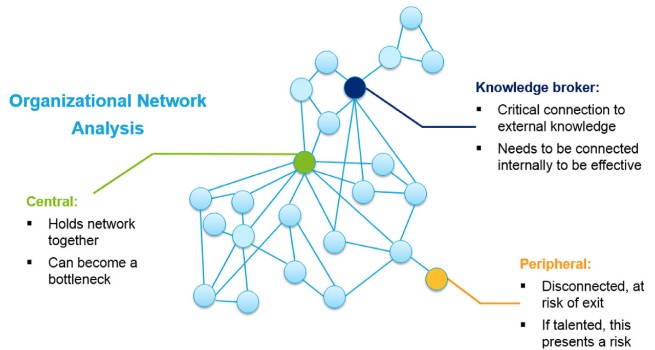Gain insight, drive smart
â Visualizing and analyzing formal and informal relationships in your organization can help you shape business strategy that maximizes organic exchange of information, thereby helping your business become more sustainable and effective.
See beyond the organization chart
In every organization, people build informal âgo-toâ teams. They rely on that one person who always knows âhow we do things here.â They find someone in finance who can answer any budget question. These spontaneous, critically important connections are the lifeblood of organizations worldwide.
Organizational Network Analysis (ONA) is a structured way to visualize how communications, information, and decisions flow through an organization. Organizational networks consist of nodes and ties, the foundation for understanding how information in your organization is flowing, can flow, and should flow.
Organizational Network Analysis (ONA) explained
Every organization has people (nodes) who serve as critical conduits for exchange of ideas and information (Figure 1). A connection delivers value when needed information is exchanged.
- Central node: These are the people who seem to know everyone. Central nodes share lots of information and influence groups quickly. Central nodes can be anywhere in the hierarchy of an organization, are often well liked, and are highly engaged in company news and developments.
- Knowledge broker: These people create bridges between groups. Without knowledge brokers, information and idea sharing grinds to a halt.
- Peripheral: Easily overlooked and unconnected to the rest of the company, high-potential peripherals can be a risk to organizations. Exceptional Java coders who donât teach others best practices not only stagnate product development, they are also easily convinced to take their talents elsewhere.
- Ties: Ties are the formal and informal relationships between nodes. Establishing optimal relational ties between central nodes and knowledge brokers helps ensure useful information moves easily between and within groups.
These nodes and ties are the core elements of ONA. Visualizing the relationships between nodes and ties makes it much easier to identify critical connections and potential barriers to information flow and collaboration. ONA reveals where central nodes could have the most impactâin groups that âdonât talk much,â for exampleâor where you should build stronger connections to streamline information sharing and eliminate redundancy.
Figure 1: Sample actors
By identifying and managing central nodes properly, change can be adopted more quickly and pervasively, helping limit costly disruption while the organization is aligned with business strategy.

Unlock the power of networks
Increase operational effectiveness
Formal organization charts often bear little resemblance to the web of people who actually execute work. ONA can offer valuable insights during organizational design, making it easier to establish future structures that position employees where they can deliver the most impact.
Transform organizations in a smarter way
Very often, leaders identified on an org chart are not the true hubs of information flow or perceived as âgo-toâ people. Itâs easy to rely on word-of-mouth and managerial heuristics to identify people to serve as change agents during new organization rollout and transformation. But more frequently than not, the people identified through these approaches are not the ârealâ leaders. ONA increases the chances that the natural leaders in your organization are on board and the transformation achieves the intended objectives.
Use talent efficiently
Actual, day-to-day work cannot be fully represented by a job title or captured in an org chat. ONA can reveal which positions and units are interacting to get work done.
- Functional clarity: Are all IT infrastructure resources aligned with your shared IT group? Are finance employees the only ones executing close-book activities at year end? Conducting an ONA can expose the true resource cost of activities as well as the actual work performed under each job title. ONA provides a fresh, informed perspective for defining the future state of functions and activities, from department level to individual contributor.
- Role definition: ONA shows where work starts, stalls, and stops. This can provide valuable insight into the current and future state of decision making and governance in your organizationâand makes it easier to see how to integrate the right people into the flow. For example, during M&A activity, inaccurate or differently defined job titles can make roles seem different when they are actually the same. Through ONA, organizations can help identify role redundancy within a network, potentially freeing talent to fill more value-added activities.
Using ONA to inform organization design efforts can help:
- Increase operational effectiveness by building an organization that is structured to increase collaboration and exchange of information between the right people.
- Transform organizations in a smarter way by identifying formal and informal leaders who can be counted on to facilitate change and help accelerate the realization of transformation benefits.
- Use talent more effectively by minimizing role confusion and redundancy.





